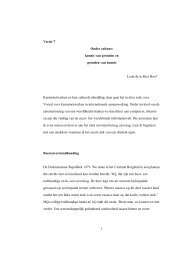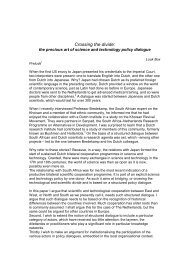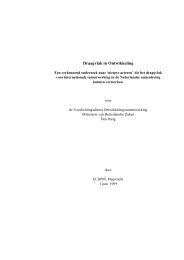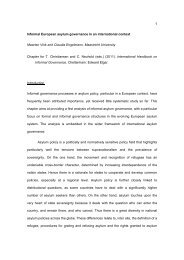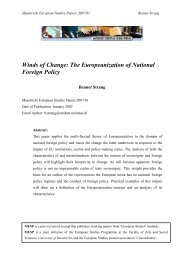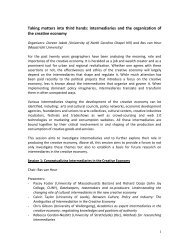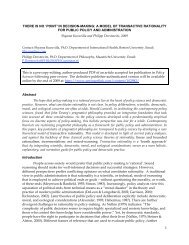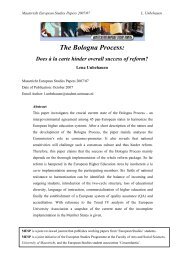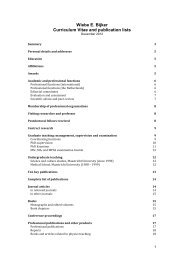the case of the synthetic dye industry, 1857–1914 - Maastricht ...
the case of the synthetic dye industry, 1857–1914 - Maastricht ...
the case of the synthetic dye industry, 1857–1914 - Maastricht ...
Create successful ePaper yourself
Turn your PDF publications into a flip-book with our unique Google optimized e-Paper software.
192 J.P. Murmann and E. Homburg<br />
Comparing <strong>the</strong> distribution <strong>of</strong> plants across firms in <strong>the</strong> five different countries<br />
Earlier, at <strong>the</strong> global level, we saw that <strong>the</strong> frequency <strong>of</strong> multi-plant firms increased<br />
over time (see Table 2). Before examining whe<strong>the</strong>r this pattern holds<br />
true in <strong>the</strong> five major countries as well, it is useful to look at <strong>the</strong> distribution<br />
<strong>of</strong> multi-plant firms for each country over <strong>the</strong> entire period. Table 3 reveals that<br />
only German and French firms ever had more than two domestic plants. And<br />
only German firms ever operated at home more than three plants at <strong>the</strong> same<br />
time. The temporal dynamics at <strong>the</strong> country level are also noteworthy. The trend<br />
<strong>of</strong> an increasing frequency <strong>of</strong> multi-plant firms that we saw at <strong>the</strong> global level is<br />
not true for every single country. Again comparing <strong>the</strong> period before 1887 with<br />
<strong>the</strong> period 1887-1914, <strong>the</strong> number <strong>of</strong> multi-plant firms declines in Britain and<br />
France. 15 German firms were clearly driving <strong>the</strong> global pattern. The frequency<br />
<strong>of</strong> 3-plant firms increases from 4.4 % to 6.9%, 4-plant firms from 0.6% to 2.9%<br />
and 5-plant firms from 0% to 1.0%.<br />
Table 3. Number <strong>of</strong> <strong>dye</strong> plants per firm across <strong>the</strong> different countries<br />
Numbers Number <strong>of</strong> firm-years (% in paren<strong>the</strong>ses)<br />
<strong>of</strong> Britain France Germany Switzerland U.S.<br />
plants/<br />
firm<br />
Home All Home All Home All Home All Home All<br />
1 834 747 966 683 2082 1813 352 272 492 325<br />
(83.1) (79.3) (93.4) (87.6) (80.2) (72.5) (96.7) (78.6) (97.8) (96.7)<br />
2 169 173 62 75 295 308 12 30 11 11<br />
(16.8) (18.4) (6.0) (9.6) (11.4) (12.3) (3.3) (8.7) (2.2) (3.3)<br />
3–4 0 22 6 18 204 291 0 40 0 0<br />
(0.0) (2.3) (0.6) (2.3) (7.5) (11.6) (0.0) (11.6) (0.0) (0.0)<br />
5–6 0 0 0 4 16 57 0 4 0 0<br />
(0.0) (0.0) (0.0) (0.5) (0.6) (2.3) (0.0) (1.2) (0.0) (0.0)<br />
7–9 0 0 0 0 0 30 0 0 0 0<br />
(0.0) (0.0) (0.0) (0.0) (0.0) (1.2) (0.0) (0.0) (0.0) (0.0)<br />
Total 1003 942 1034 780 2597 2499 364 346 503 336<br />
Explanation <strong>of</strong> <strong>the</strong> table: “Home” refers to domestic plants <strong>of</strong> a firm; “All” refers to <strong>the</strong> sum <strong>of</strong> (1)<br />
<strong>the</strong> domestic plants that are not owned by a foreign firm and (2) <strong>the</strong> plants owned by domestic firms<br />
in o<strong>the</strong>r countries.<br />
When <strong>the</strong> analysis also includes plants that firms owned in foreign countries,<br />
<strong>the</strong> patterns are even more striking. If a German firm owned a plant in <strong>the</strong> U.S.,<br />
for example, <strong>the</strong> plant would not be counted in this analysis among <strong>the</strong> U.S.<br />
plants but among <strong>the</strong> German. The maximum number <strong>of</strong> plants controlled by a<br />
particular firm <strong>the</strong>n jumps from 5 to 9 for Germany, from 2 to 6 for Switzerland,<br />
from 3 to 6 for France, and from 2 to 3 for Britain. In <strong>the</strong> <strong>case</strong> <strong>of</strong> <strong>the</strong> U.S. <strong>the</strong><br />
maximum remains at 2. The trend toward multi-plant firms appears not to be true<br />
for Britain, and only partially true for France (<strong>the</strong> percentage <strong>of</strong> 2-plant firms<br />
15 More detailed figures on <strong>the</strong> distribution <strong>of</strong> plants across firms for <strong>the</strong> different national industries<br />
can be obtained from <strong>the</strong> first author upon request.



